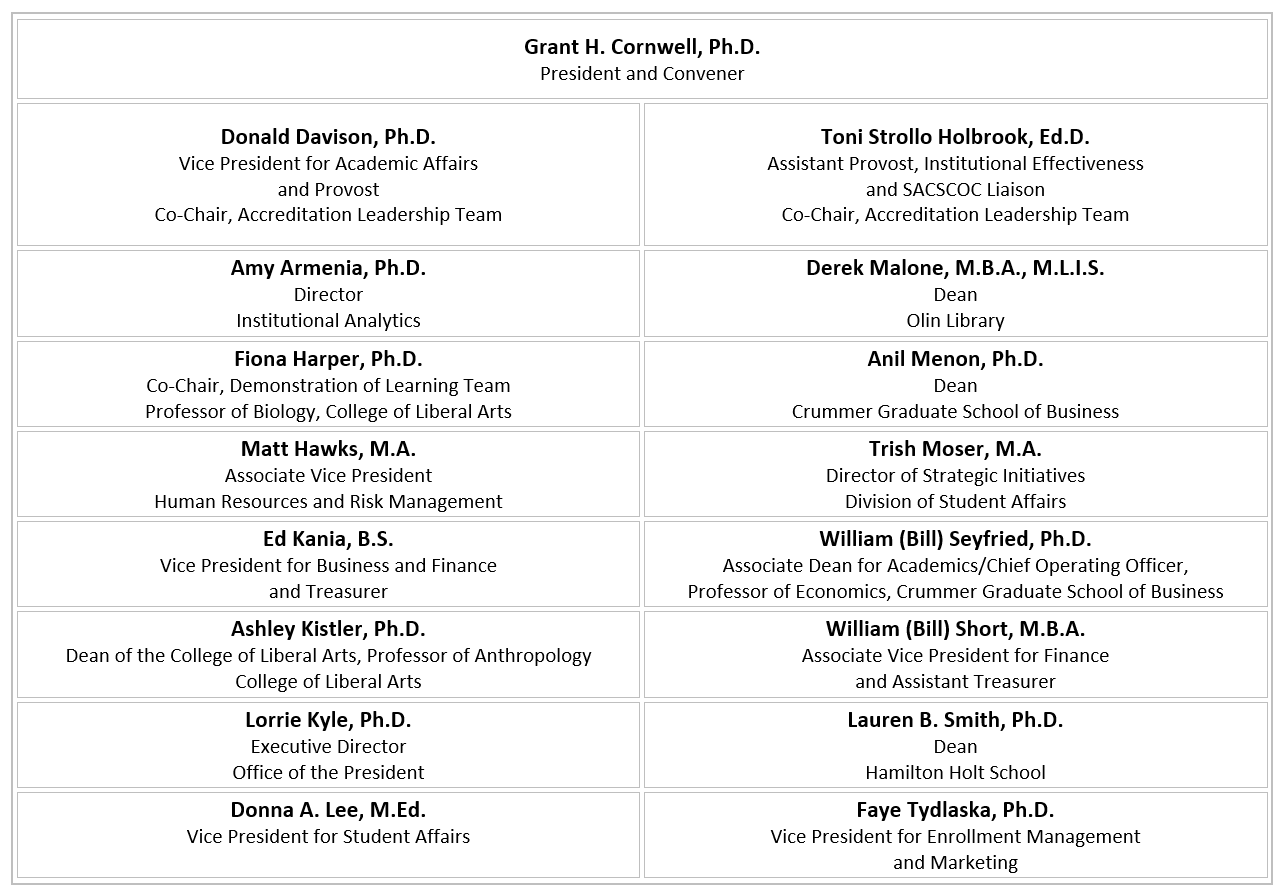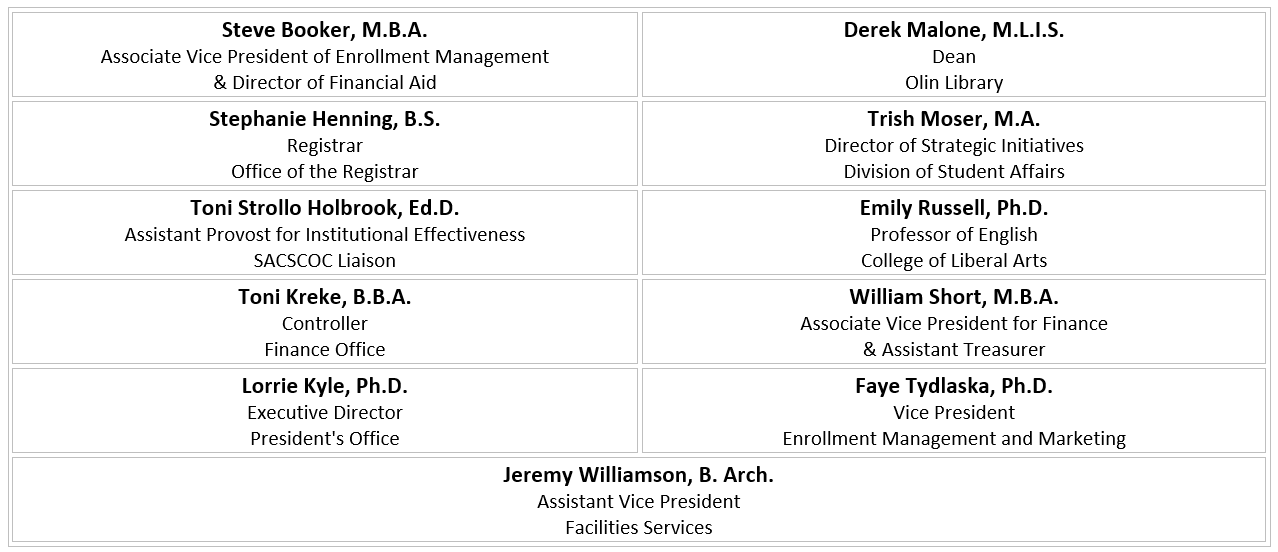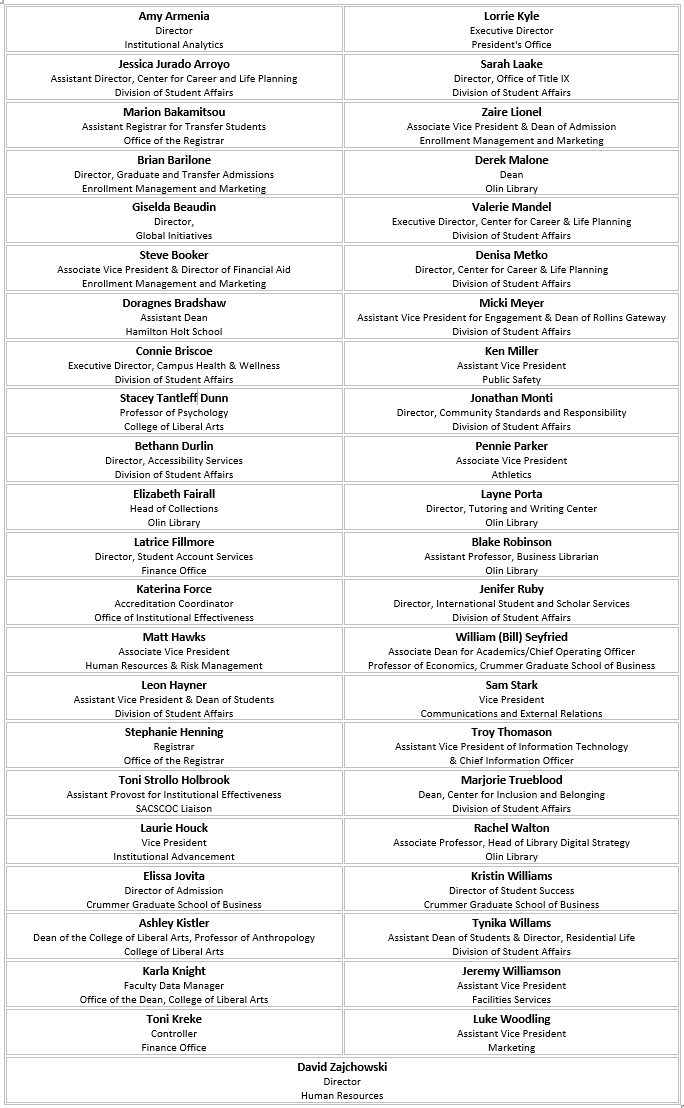VP for Academic Affairs and Provost
Reaffirmation of Accreditation
Accreditation is a form of self-regulation and quality assurance in higher education. The Southern Association of Colleges and Schools Commission on Colleges (SACSCOC) is the recognized accrediting body for higher education institutions that award associate, baccalaureate, masters, or doctoral degrees in the 11 U.S. southern states (Alabama, Florida, Georgia, Kentucky, Louisiana, Mississippi, North Carolina, South Carolina, Tennessee, Texas, and Virginia), Latin America, and certain other international sites. Reaffirmation of accreditation requires the submission of a Fifth Year Interim Report (FYIR), decennial Compliance Certification Report (CCR), the development of a Quality Enhancement Plan (QEP), off-site and on-site reviews, and review by the Commission. Rollins was first accredited by SACSCOC in 1927 and has been continuously accredited since that time. Official information regarding the College's regional accreditation may be found on the Office of Institutional Analytics website.
The College’s 2015 reaffirmation of accreditation Compliance Certification Report, a nearly 500-page document, was submitted to SACSCOC in February 2015. A subsequent on-site visiting committee of representatives from peer institutions from across Southern states took place in March 2015. On December 8, 2015, at the SACSCOC annual meeting, the College's institutional accreditation was reaffirmed with no recommendations for improvement. The College’s accreditation is assured through 2025, when the next decennial review will occur. The College's Fifth Year Interim Report and Quality Enhancement Plan (QEP) Impact Report were accepted by SACSCOC in June 2022 with no recommendations for improvement. The College's next decennial reaffirmation Compliance Report will be submitted to SACSCOC in September 2024.
Institutional Accreditation 101
Q. What is accreditation?
A. Accreditation is a form of self-regulation and quality assurance in higher education. In the U.S., accreditation is coordinated by a non-governmental non-profit organization, the Council for Higher Education Accreditation (CHEA), and the U.S. Department of Education. Rollins’ USDE-recognized institutional accreditor is the Southern Association of Colleges and Schools Commission on Colleges (SACSCOC). SACSCOC is authorized to accredit institutions in southern states, Latin America, and several international locations. Comprised of its members, Rollins among them, SACSCOC accredits institutions that have missions appropriate to higher education, devote resources to carrying out those missions, and can show that they do, in fact, achieve those missions.
Q. Does Rollins really need to be accredited?
A. Institutions that want access to federal financial aid for their students hold USDE-recognized accreditation. So, yes: Rollins needs to be accredited.
Q. Is accreditation something new?
A. No. As more and more students began attending colleges across the U.S., accreditation organizations formed in the late 19th and 20th centuries to ensure consistency in academic standards across institutions. The Southern Association of Colleges and Schools (SACS) was founded in 1895; the Commission on Colleges (SACSCOC) was founded in 1917, “and was organized to develop standards and a process for accrediting colleges and universities in the South,” according to the organization’s website. Rollins was first accredited by SACSCOC in 1927, and has been continuously accredited since that time.
Q. How often must an institution seek a reaffirmation of its accreditation?
A. An accredited institution like Rollins seeks a reaffirmation of accreditation every 10 years by undertaking a detailed self-study of its practices and submitting a required Compliance Certification Report (CCR) demonstrating its adherence to accreditor standards. The CCR shows the extent to which Rollins complies with each of the core requirements and standards presented in the SACSCOC Principles of Accreditation. For SACSCOC, a Quality Enhancement Plan (QEP) and project are required, along with a Fifth Year Interim Report (FYIR) in intervening years.
Q. How many requirements, standards, and regulations are there?
A. SACSCOC accredited institutions are asked currently to assure institutional compliance with about 75 core requirements and standards organized into 14 sections. While some of these standards do not apply to Rollins (e.g., questions about associate’s degrees), the College must still respond to each one, even if we only say, “This standard does not apply to Rollins.”
Q. Give an example of a standard.
A. Here are four examples that show some of the breadth and depth of the SACSCOC Principles of Accreditation core requirements and standards.
- Section 7, Standard 7.1 Institutional Planning. The institution engages in ongoing, comprehensive, and integrated research-based planning and evaluation processes that (a) focus on institutional quality and effectiveness and (b) incorporate a systematic review of institutional goals and outcomes consistent with its mission. [Core Requirement]
- Section 8, Standard 8.1 Student Achievement. The institution identifies, evaluates, and publishes goals and outcomes for student achievement appropriate to the institution's mission, the nature of the students it serves, and the kinds of programs offered. The institution uses multiple measures to document student success. [Core Requirement]
- Section 9, Standard 9.1 Program Content. Educational programs (a) embody a coherent course of study, (b) are compatible with the stated mission and goals of the institution, and (c) are based on fields of study appropriate to higher education. [Core Requirement]
Q. Reaffirmation of accreditation sounds pretty demanding.
A. It is. Completing the CCR requires the collaboration of the entire campus. In addition, each claim that Rollins makes in the CCR must be backed up by documentation, in much the same way that a scholarly article would footnote its sources. Nearly 2,200 documents were gathered in completing the 2015 Rollins CCR.
Q. What if Rollins undergoes a dramatic change? Does that affect our accreditation?
A. SACSCOC defines “Substantive Change” as a significant departure from, modification of, or expansion in the nature and scope of an accredited institution. Some changes require only that SACSCOC is notified in advance; others require that a detailed and documented prospectus describing the proposed change and the College's capacity to successfully undertake it be submitted at least six months prior to the start date of a new program. Others may require not only a prospectus, but also full documentation and a site visit from a SACSCOC substantive change committee. Rollins had its most recent substantive change site visit when it desired to offer a doctoral degree; this proposal changed Rollins’s SACSCOC institution level (from III, bachelor’s, to V, which allows us to offer up to three doctoral degrees) and, thus, required the onsite visit.
Q. Is SACSCOC emphasizing anything now?
A. SACSCOC is emphasizing assessment of student learning, use of assessment results to improve learning, and the demonstration of student achievement.
Q. What is the Quality Enhancement, or QEP, Plan I’ve heard about?
A. The SACSCOC Quality Enhancement Plan, or QEP, has been a reaccreditation requirement for about 30 years. SACSCOC asks all institutions to develop a QEP that (a) has a topic identified through its ongoing, comprehensive planning and evaluation processes; (b) has broad-based support of institutional constituencies; (c) focuses on improving specific student learning outcomes and/or student success; (d) commits resources to initiate, implement, and complete the QEP; and (e) includes a plan to assess achievement. Rollins developed its 2015 QEP following extensive campus conversations; the 2015 QEP, R-Compass, focused on integrating career planning into academic planning and advising. Rollins can nominate at least two experts as QEP reviewers; SACSCOC will choose one, who will be part of the site-visit team.
Q. What are the next reporting dates for regional accreditation?
A. The College submitted a Fifth-Year Interim Report (FYIR) consisting of an abbreviated compliance certification and an impact report for the College's QEP, to SACSCOC in March 2021. The Fifth-Year Interim Report report was accepted by SACSCOC without recommendations. The College's next decennial reaffirmation Compliance Report will be submitted to SACSCOC in September 2024.
Q. Where do I go for more information?
A. Go to sacscoc.org/faqs for SACSCOC’s own “frequently asked questions” section.
Last Updated: 8-17-2024
Accreditation Leadership Team (ALT)
The Southern Association of Schools and Colleges Commission on Colleges (SACSCOC) requires all institutions seeking reaffirmation of accreditation to establish an Accreditation Leadership Team (ALT). The Commission believes that the process functions most effectively when the senior administrative officers overseeing the process, the ALT, and the SACSCOC Liaison work together to guide the institution toward reaffirmation. The Rollins ALT is an ad hoc advisory group, convened by the President, to provide this guidance for the College’s 2025 reaffirmation process. The College’s ALT includes individuals with the skills, knowledge, and authority to lead the institution’s reaffirmation effort; have oversight of the required staff, data, and information required to prepare accurate and timely assessments for the Compliance Certification Report (CCR); and can ensure that the Rollins community is engaged in the self-study process.

Last Updated: 8-17-2024
Writing Team Leaders and Contributors
Writing Team Leaders
The College’s responses to the 44 SACSCOC-required standards and report components that comprise the Rollins 2025 CCR for Differentiated Review were completed by collaborative writing teams. The administrators, faculty, and staff members shown below provided leadership for one or more of those writing teams. The College’s ALT is grateful to these members of the Rollins community who led writing teams, audited processes and praxis for compliance, wrote narratives, gathered evidence documentation, and otherwise contributed to a thorough and thoughtful SACSCOC reaccreditation CCR.

The Rollins 2025 CCR for Differentiated Review was a collaborative effort involving nearly 50 administrators, faculty, and staff. The College’s ALT is grateful to the many members of the Rollins community who contributed to a thorough and thoughtful SACSCOC reaffirmation CCR.
 L
L2025 SACSCOC Reaffirmation
Philosophy, Components, and Timeline
Philosophy
Rollins College’s institutional accreditor, The Southern Association of Colleges and Schools Commission on Colleges (SACSCOC or Commission), conducts a comprehensive review of its member institutions once every 10 years. Reaffirmation of institutional accreditation requires the College to conduct a comprehensive compliance audit of all programs and courses offered by the College on- and off-campus, and through distance education, prior to preparing a Compliance Certification Report (CCR) demonstrating and documenting compliance with all standards described in the SACSCOC Principles of Accreditation. The CCR attests to the institution’s honest assessment of compliance with the accreditation requirements of the Commission as applied to all aspects of the institution. The CCR is reviewed by a team of off-site peers, an onsite peer review team, and the SACSCOC Board of Trustees.
The College must also to develop and submit a Quality Enhancement Plan (QEP) demonstration project as part of the reaffirmation process. The QEP project must be identified through institutional planning processes, have broad-based support from institutional constituencies, and be focused on improving specific learning outcomes and/or student success. The QEP project spans a five-year period and requires vigorous assessment of effectiveness, which is reported to SACSCOC through a QEP Impact Report required as part of the College’s Fifth-Year Interim Report to the Commission.
Components of the Compliance Certification Report (CCR) for Rollins
I. Signature(s) Attesting to Integrity
II. List of Substantive Changes Approved Since the 2015 Reaffirmation
III. Institutional Assessment of Compliance (including QEP Proposal)
IV. Institutional Summary Form
Standards Under Review
(Bold = Core Requirements)
| Section 1: The Principle of Integrity 1.1 [CR] Integrity |
Section 8: Student Achievement 8.1 [CR] Student Achievement 8.2.a. Student Outcomes: Educational Programs 8.2.b Student Outcomes: General Education 8.2.c Student Outcomes: Academic/Student Svcs |
| Section 2: Mission 2.1 [CR] Institutional Mission |
Section 9: Ed Program Structure & Content 9.1 [CR] Program Content 9.2 [CR] Program Length 9.3 [CR] General Education Requirements 9.4 Credits: Undergraduate Degrees 9.5 Credits: Graduate/Professional Degrees 9.6 Post-Baccalaureate Rigor & Curriculum 9.7 Program Requirements |
| Section 3: Basic Eligibility Standards 3.1.a [CR] Degree-Granting Authority 3.1.b [CR] Course Work for Degrees 3.1.c [CR] Continuous Operation |
Section 10. Ed Policies, Procedures, Practices 10.1 Academic Policies 10.2 Public Information 10.3 Archived Information 10.4 Academic Governance 10.5 Admissions Policies & Practices 10.6 Distance & Correspondence Education 10.7 Policies for Awarding Credit 10.8 Evaluating & awarding Academic Credit 10.9 Cooperative Academic Arrangements |
| Section 4: Governing Board 4.1 [CR] Board Characteristics 4.2.a Mission Review 4.2.b Board/Administrative Distinction 4.2.c CEO Evaluation/Selection 4.2.d Conflict of Interest 4.2.e Board Dismissal 4.2.f External Influence 4.2.g Board Self-Evaluation 4.3 Multi-Level Governance |
Section 11. Library & Learning/Info Rscs 11.1 [CR] Library & Learning/Info Rscs 11.2 Library & Learning/Info Staff 11.3 Library & Learning/Info Access |
| Section 5: Admin & Organization 5.1 [CR] Chief Executive Officer 5.2.a CEO Control 5.2.b Control of Intercollegiate Athletics 5.2.c Control of Fund-Raising Activities 5.3 Institution-Related Entities 5.4 Qualified Admin/Academic Officers 5.5 Personnel Appointment & Evaluation |
Section 12: Academic & Student Support Svcs 12.1 [CR] Student Support Svcs 12.2 Student Support Svcs Staff 12.3 Student Rights 12.4 Student Complaints 12.5 Student Records 12.6 Student Debt |
| Section 6: Faculty 6.1 [CR] Full-Time Faculty 6.2.a Faculty Qualifications 6.2.b Program Faculty 6.2.c Program Coordination 6.3 Faculty Appointment & Evaluation 6.4 Academic Freedom 6.5 Faculty Development |
Section 13. Financial & Physical Resources 13.1 [CR] Financial Resources 13.2 [CR] Financial Documents 13.3 Financial Responsibility 13.4 Control of Finances 13.5 Control of Sponsored Rsch/External Funds 13.6 Federal & State Responsibilities 13.7 Physical Resources 13.8 Institutional Environment |
| Section 7: Planning & Effectiveness 7.1 [CR] Institutional Planning 7.2 Quality Enhancement Plan 7.3 Administrative Effectiveness |
Section 14. Transparency & Representation 14.1 Publication of Accreditation Status 14.2 Substantive Change 14.3 Comprehensive Institutional Reviews 14.4 Representation to Other Agencies 14.5 Policy Compliance |
Timeline
Academic Year 2021-2022 (August 2021-May 2022): PREPARATION YEAR- Preparation Year (Note: Ongoing processes are necessary to fulfill reaffirmation requirements. Rollins strives to meet its commitment to accreditation standards.)
- Establishment of Structure(s) for the Process (i.e., early discussions on committees and requirements)
- Request for Participation in Differentiated Review Submitted to SACSCOC (June)
- Fall 2022
- Accreditation Leadership Team (ALT) Affirmed (October)
- Participation in Differentiated Review Approved by SACSCOC (October)
- Exploration of Possible Topics for the Quality Enhancement Plan (QEP) and Possible Planning Committee
- ALT Reviews Mapping of Writing Assignment Plans (November)
- SACSCOC Reaffirmation Class of 2025 Orientation with Senior Staff (December)
- Spring 2023
- Demonstration of Learning Team (DLT) Affirmed (January)
- Round One Writing Assignments Distributed
- Summer 2023
- Round Two Writing Assignments Distributed
- Fall 2023
- QEP Topic Development Committee Named/Charged
- Round Three Writing Assignments Distributed; Due November 30
- Round Four Writing Assignment Distributed
- Editing of Round One, Two, and Three Narratives/Uploading of Evidence
- Troubleshoot Areas of Concern
- Spring 2024
- Round Four Writing Assignments: Due May 1
- Editing of Round Four Narratives/Uploading of Evidence
- Summer 2024
- Round Five Writing Assignments: Due July 15
- Finalize All Narratives and Evidence
- Produce Final Report in Xitracs
- Final Draft of QEP Proposal Due (August 15)
- September 6, 2024: QEP Lead Evaluator Nomination Due
- September 8, 2024: Reaffirmation Compliance Report Due to SACSCOC
- November 5-8, 2024: SACSCOC Off-Site Committee Reviews Rollins’ Compliance Report
- February 3, 2025: Response Report (if any) and QEP Proposal and Due to SACSCOC (Six weeks prior to On-Site Visit)
- March 17-20, 2025: On-Site Review
- August 17, 2025: Response to On-Site Committee Report (if any) Due to SACSCOC (Five months after On-Site Visit)
- December 4-7, 2025: SACSCOC Board of Trustees Action